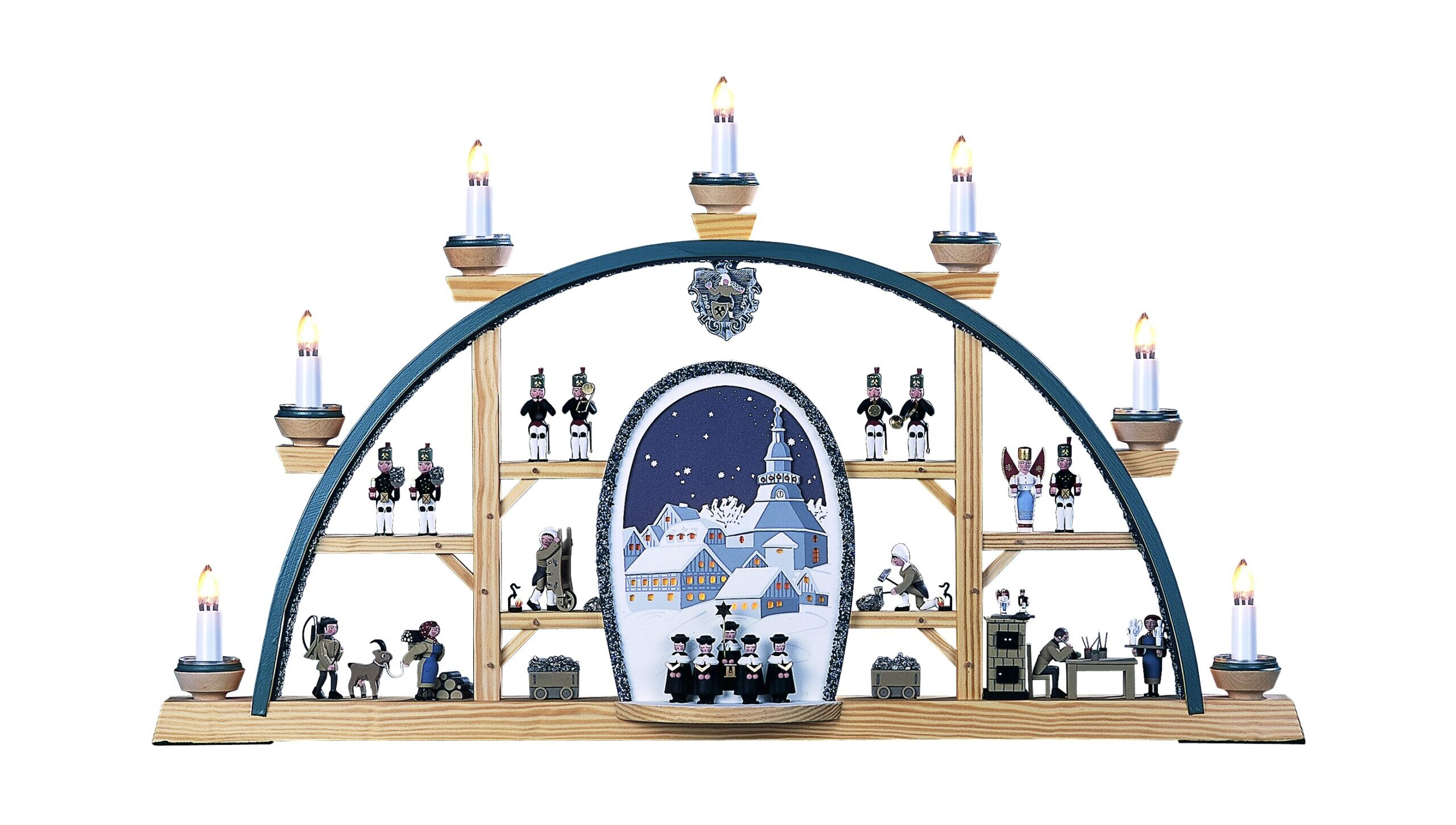
(Size 70cm x 40cm)
with 8 electric candles including interior lighting, mouth hole painted on both sides
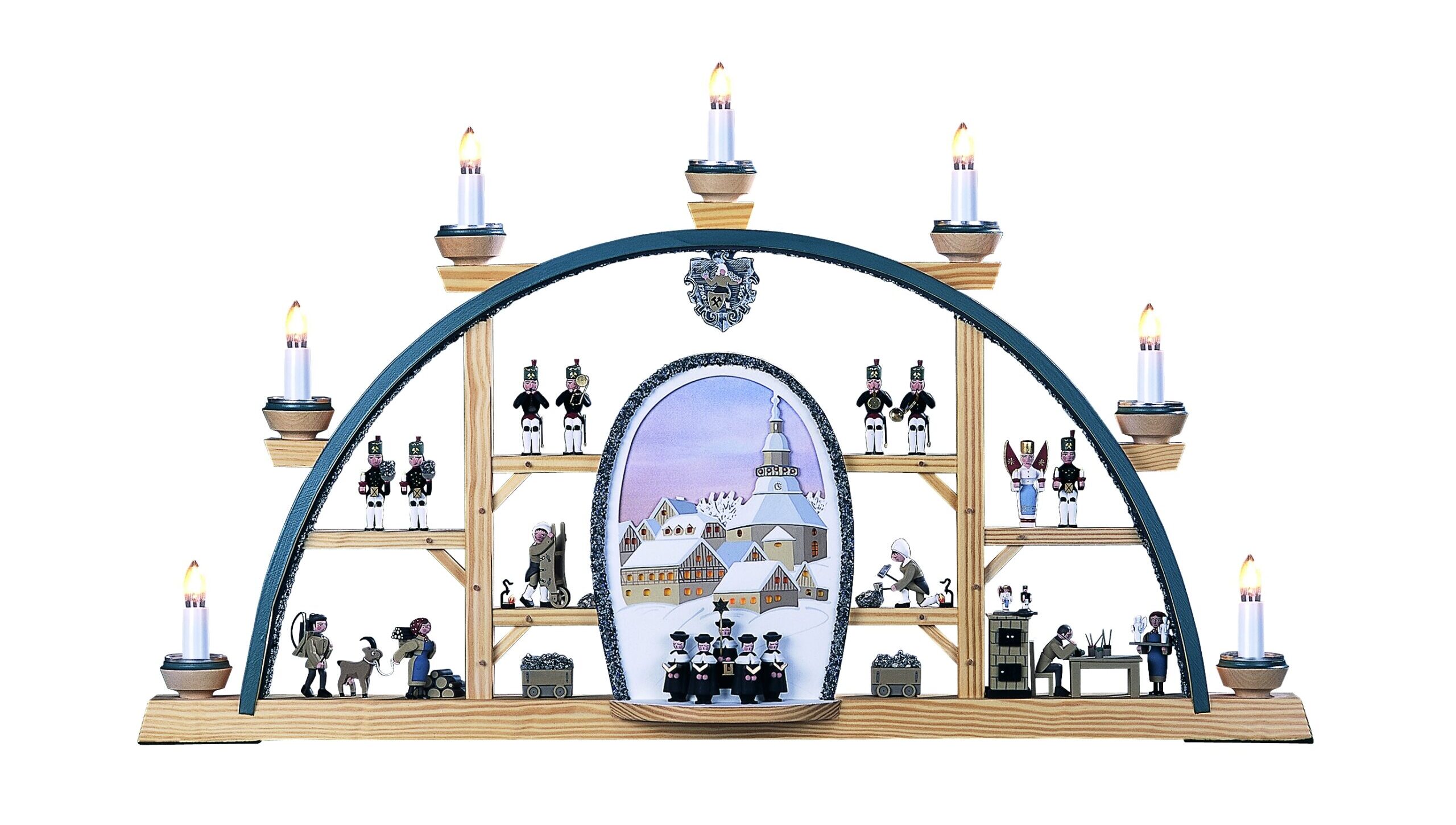
(Size 70cm x 40cm)
with 8 electric candles including interior lighting, mouth hole painted on both sides
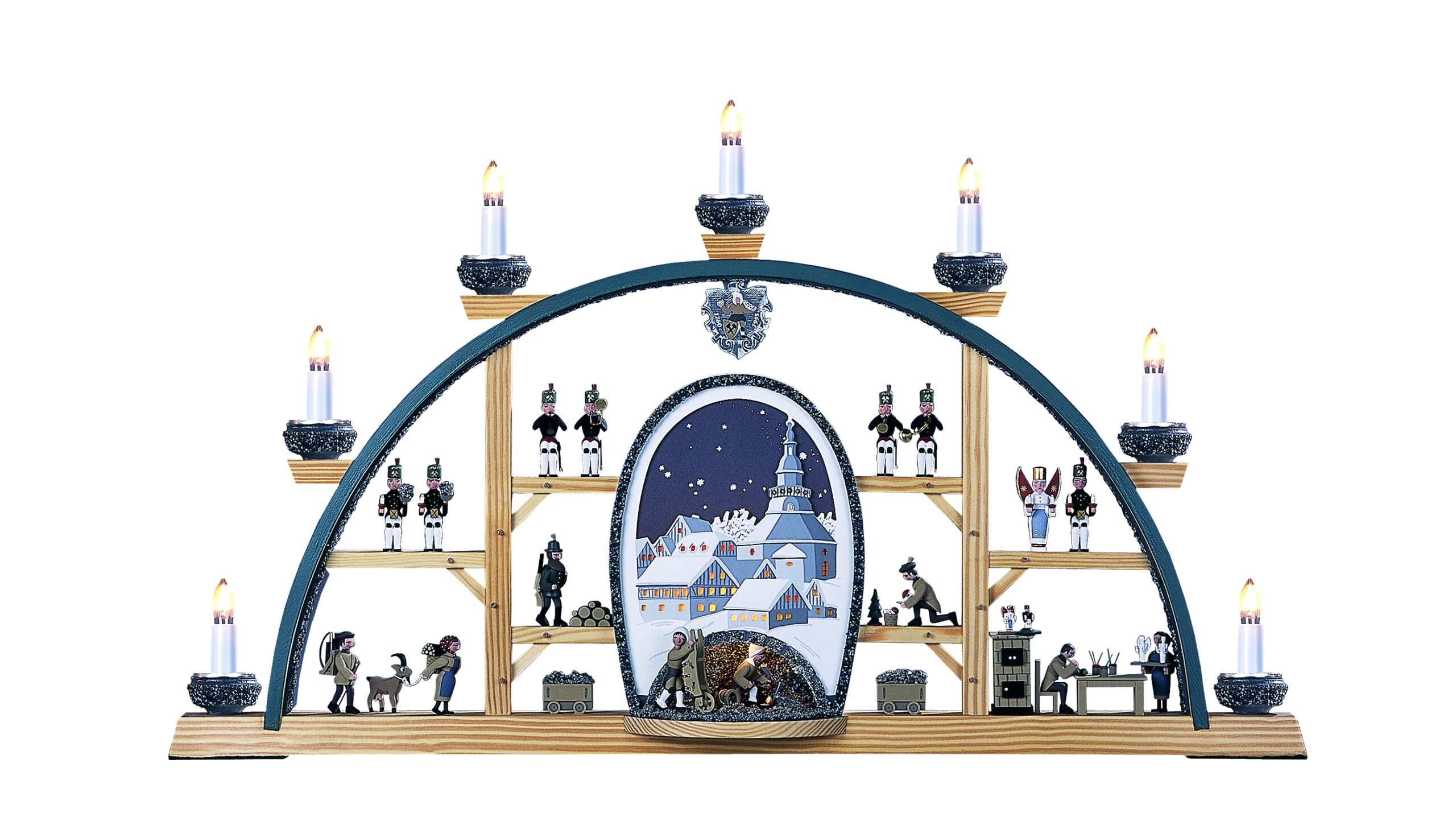
(Size 70cm x 40cm)
with 8 electric candles including interior lighting, mouth hole painted on both sides

(Size 70cm x 40cm)
with 8 electric candles including interior lighting, mouth hole painted on both sides
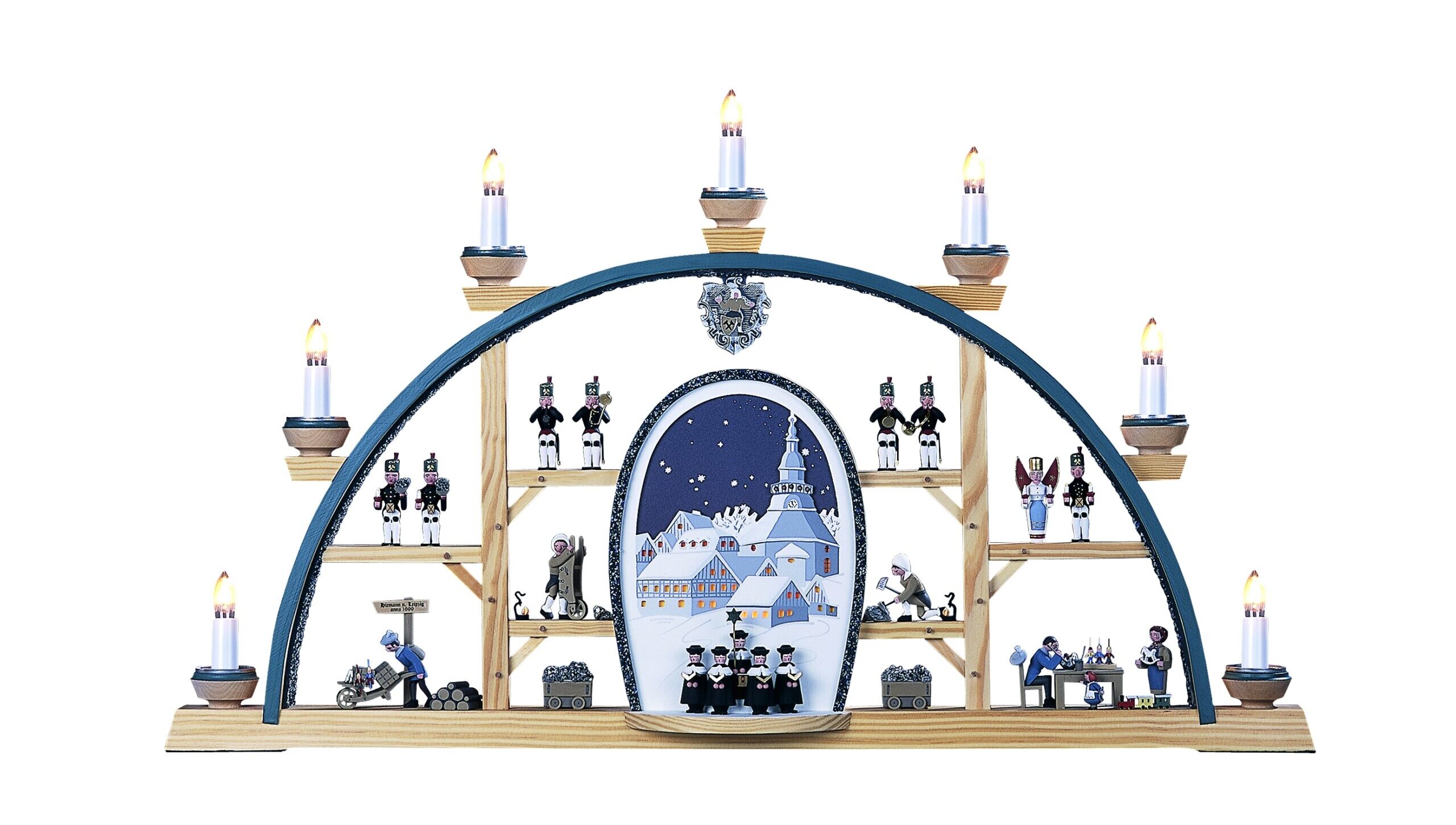
(Size 70cm x 40cm)
with 8 electric candles including interior lighting, mouth hole painted on both sides
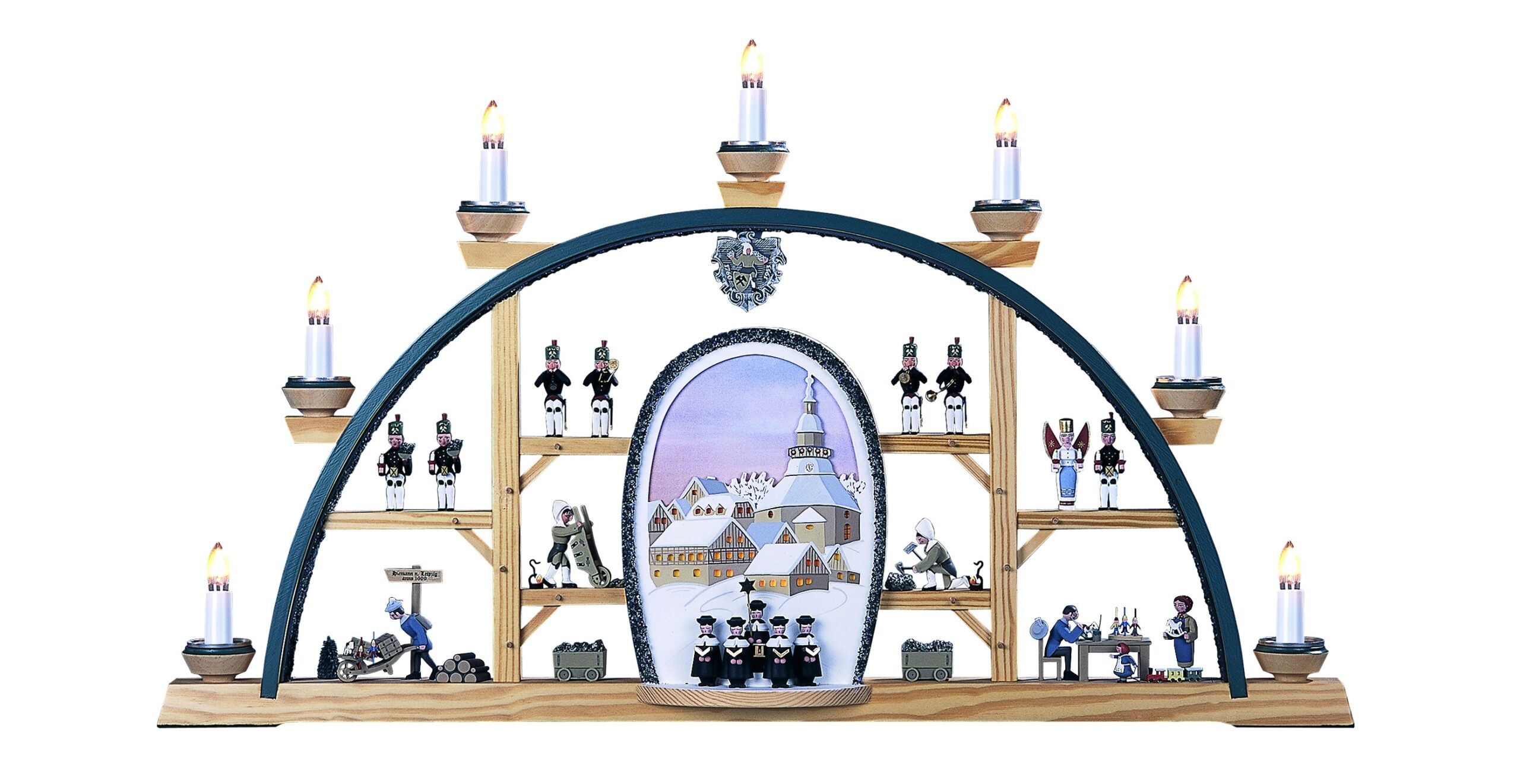
(Size 70cm x 40cm)
with 8 electric candles including interior lighting, mouth hole painted on both sides
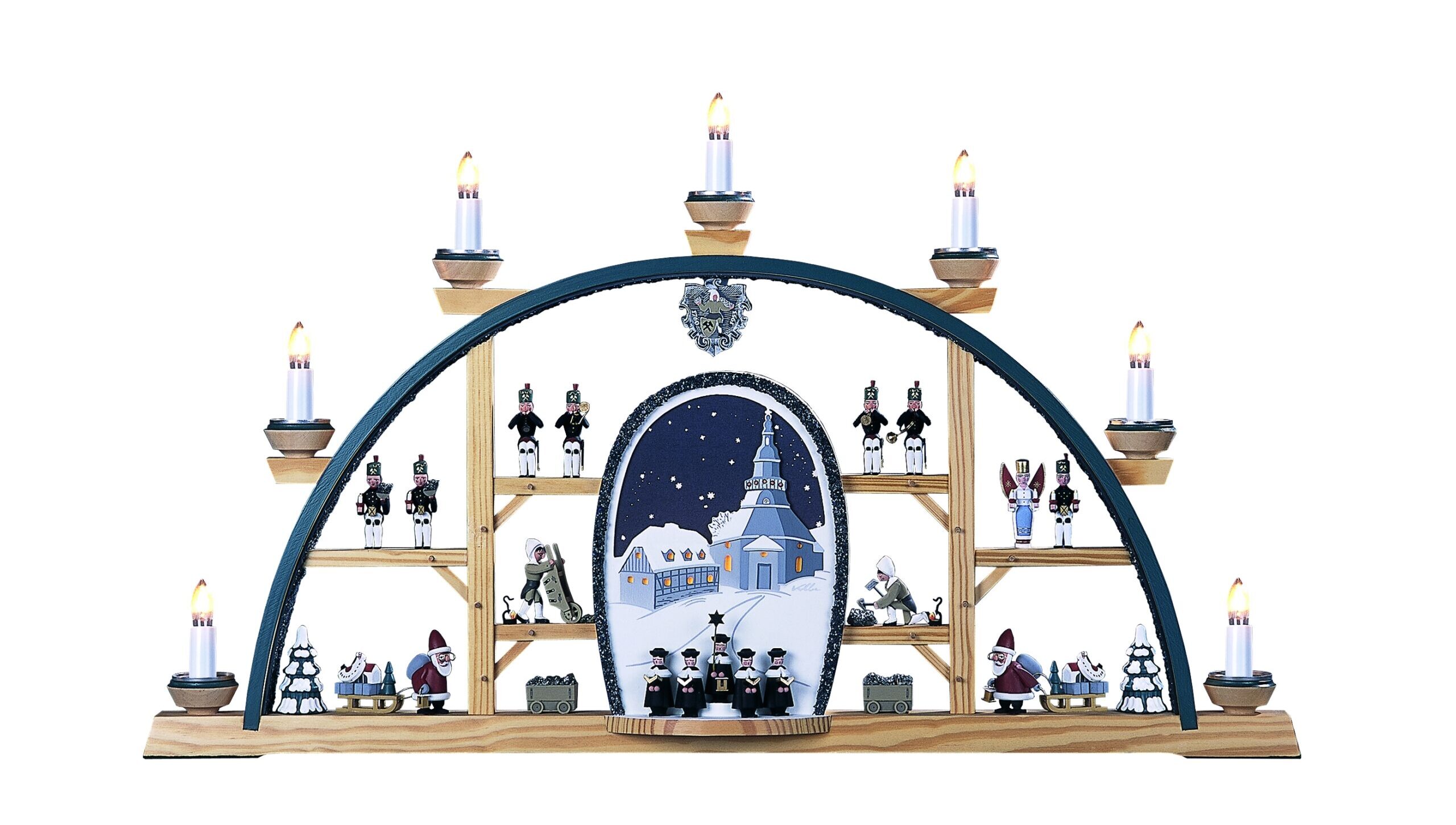
(Size 70cm x 40cm)
with 8 electric candles including interior lighting, mouth hole painted on both sides
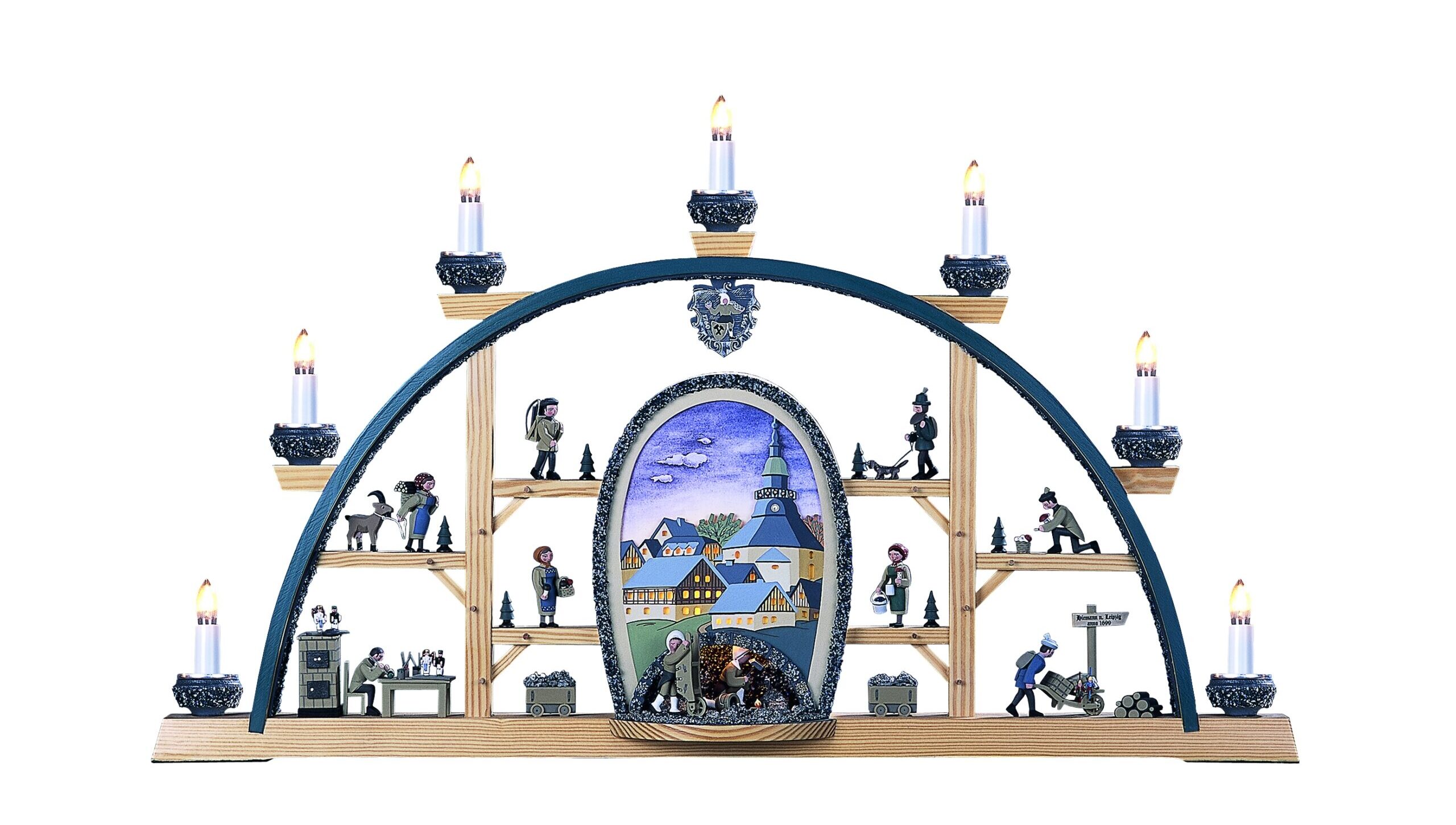
(Size 70cm x 40cm)
with 8 electric candles including interior lighting, mouth hole painted on both sides
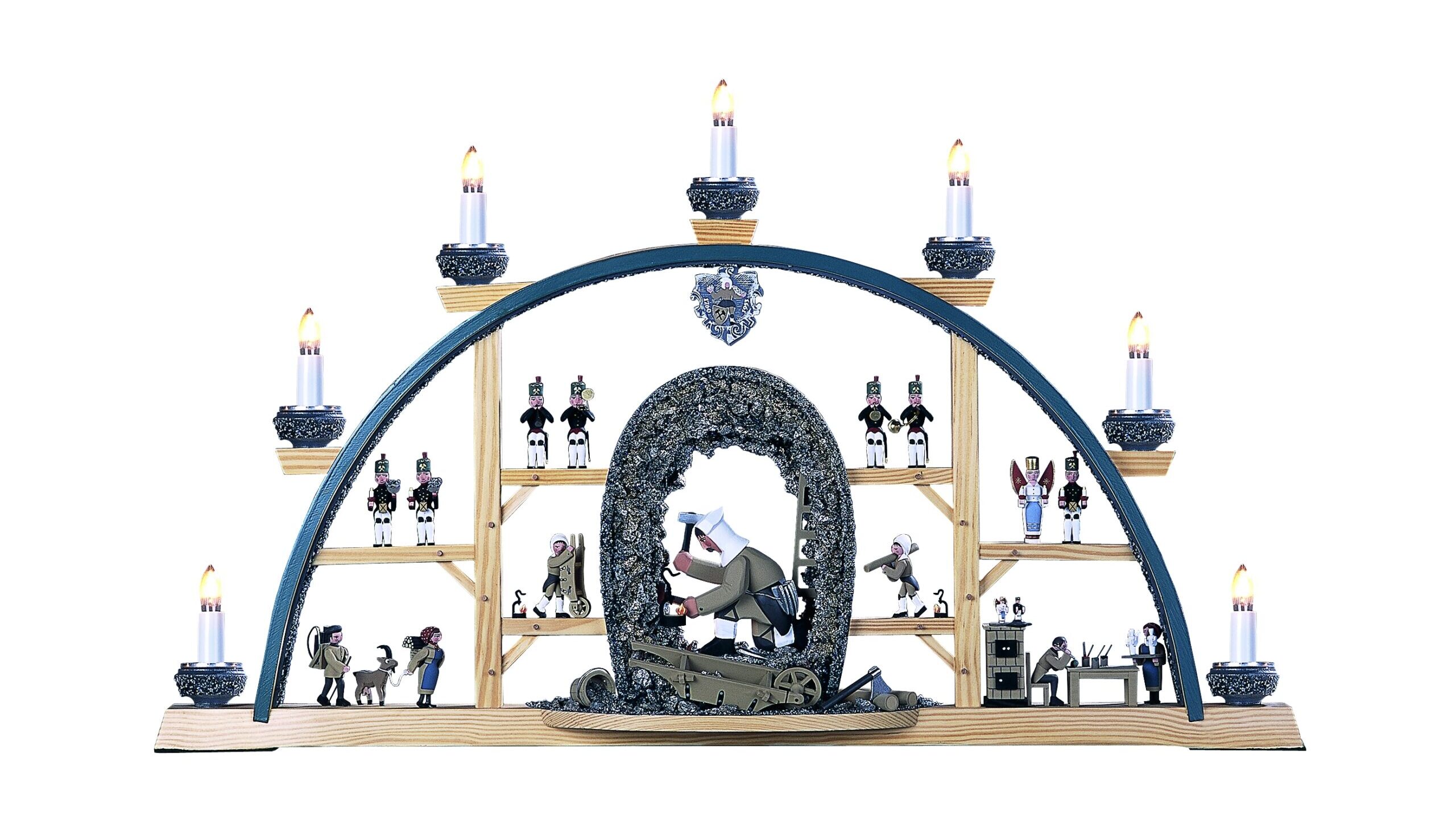
(Size 70cm x 40cm)
with 8 electric candles including interior lighting
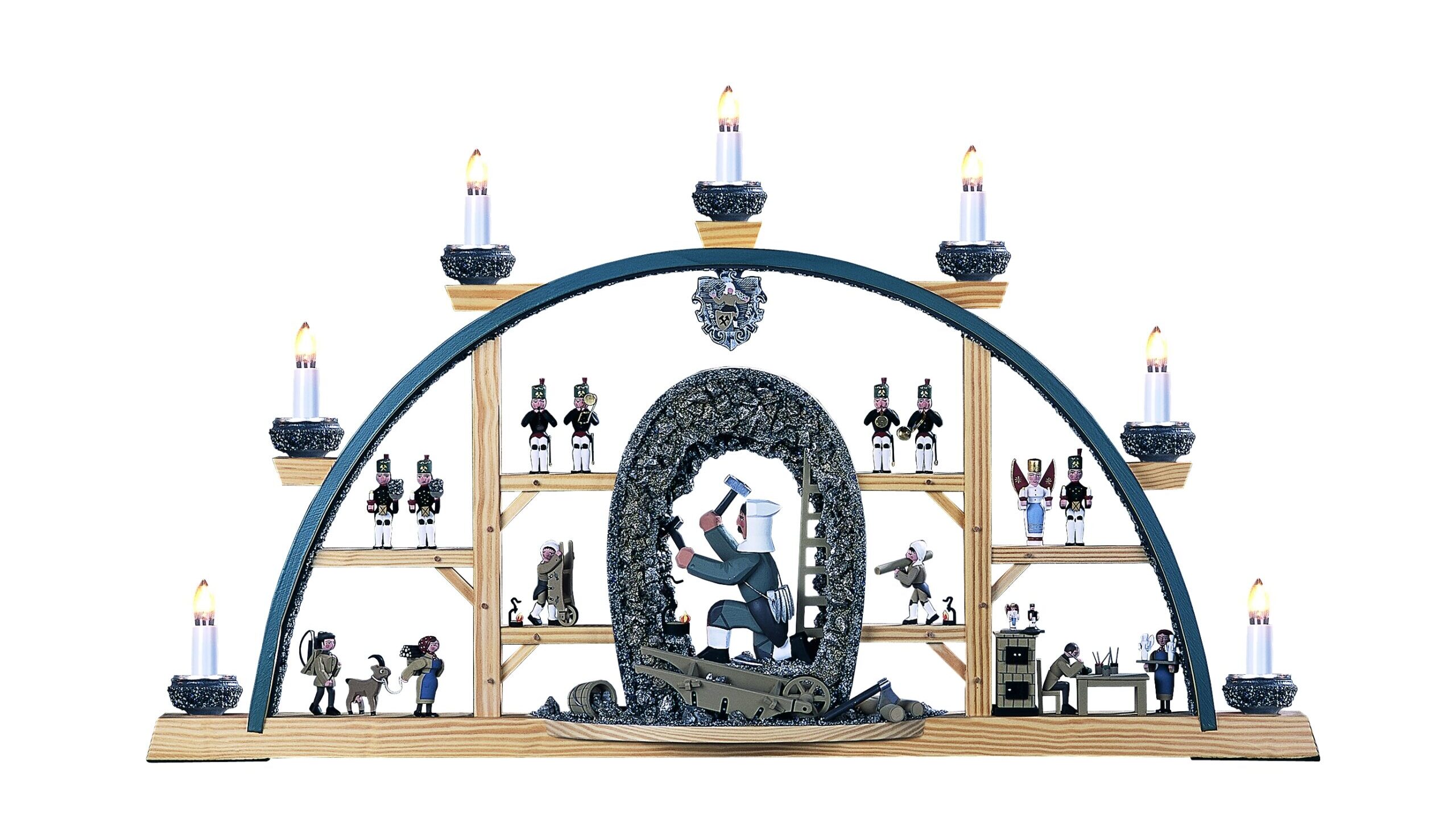
(Size 70cm x 40cm)
with 8 electric candles including interior lighting
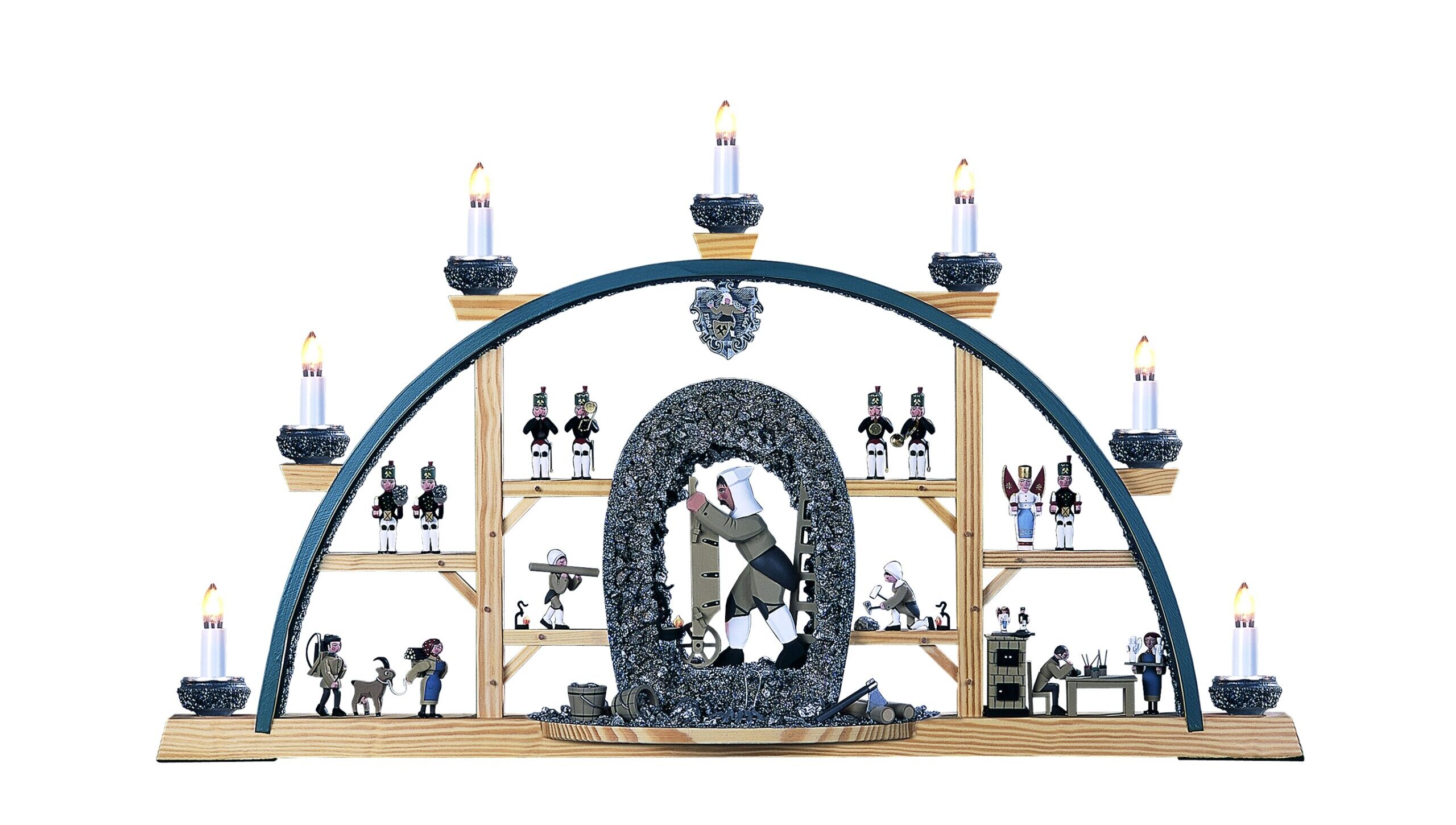
(Size 70cm x 40cm)
with 8 electric candles including interior lighting
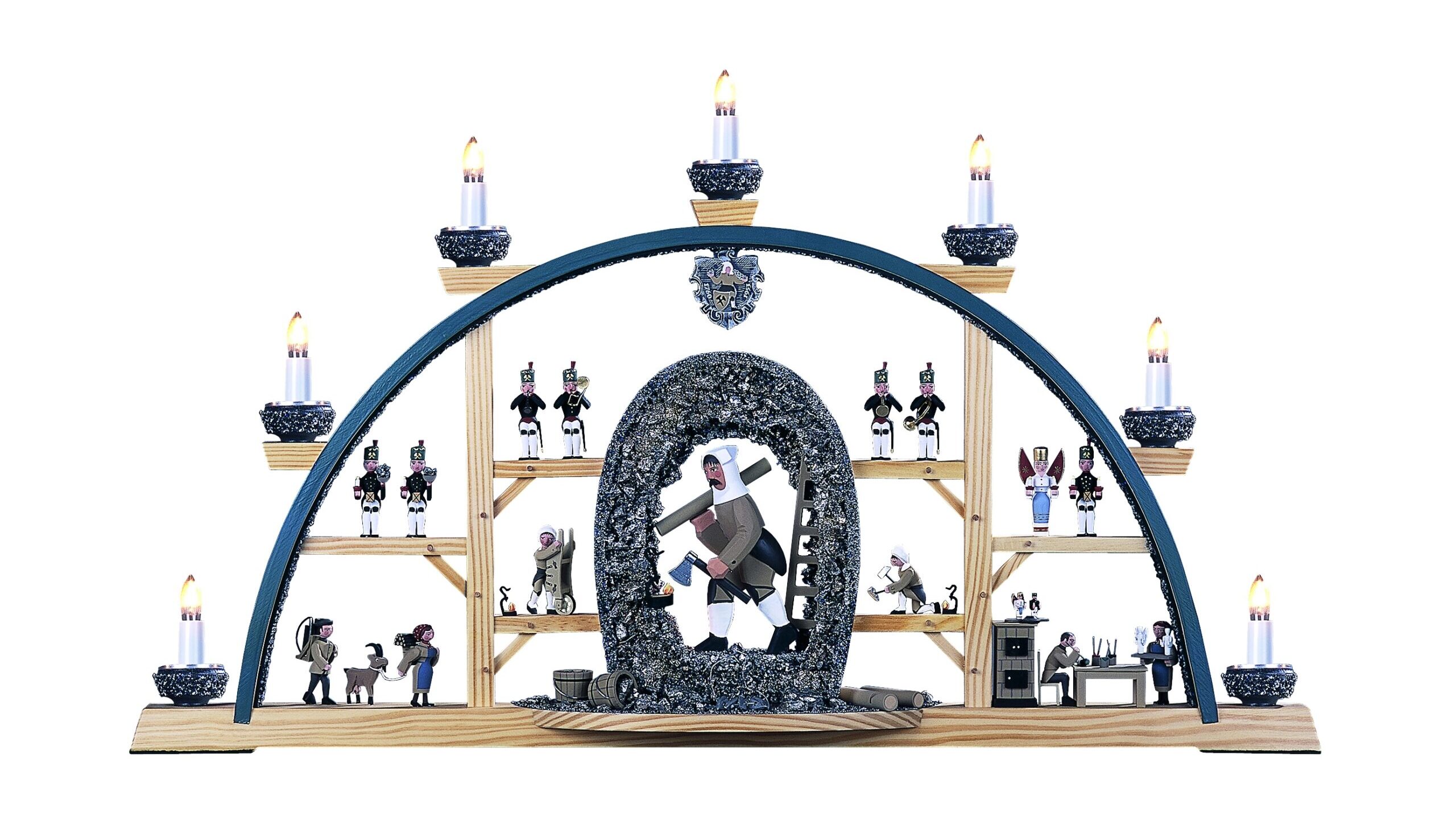
(Size 70cm x 40cm)
with 8 electric candles including interior lighting
Carving, bobbin lace making and toy making are typical folk arts of the Ore Mountains and have their origins in the former mining industry, which dominated the economic life of this region in the 15th and 16th centuries.
With its increasing decline from the 17th century onwards, numerous mining families also lost their livelihood. In search of a new way of earning a living, they found it in new professions in wood processing or in home-made textile production.
For the Western Ore Mountains this became lace making, and for the Seiffen area it was wood turning and toy making. We took up this development, which was economically caused by the decline of mining, and designed it in a cycle “From miner to toy maker” based on the basic principle of our factory of realistically depicting historical contexts. The starting point for this is again the original “Seiffen candle arch”, which has been sensibly expanded with mining elements. The close connection to mining is always symbolised by a tunnel entrance, which is at the centre of the arch. It provides a view of the toy village of Seiffen or shows scenes from the miner’s work. The sides, designed in the semicircle of the arch, reflect the development of the path from miner to toy maker in figurative designs. A forest worker points out the importance of wood as a raw material for the toy maker, and the wood collector next to him symbolises her social situation with her goat, the “little man’s cow”. On the other side of the arch, a toy maker and his wife are making light miners and light angels, as well as candle arches in delicate miniature versions. The Seiffen toymaker Hiemann points to a significant event for the spread of Seiffen toys on the world market: in 1699 he was the first to visit the Leipzig trade fair and transported his turned goods to Leipzig on foot on a trestle.
But Santa Claus with a sleigh full of toys is also included in this range. These depictions are framed by typical Erzgebirge figures and miners playing music.
The cycle “From miner to toymaker” was also recognized when these candle arches were awarded the “Tradition and Form” prize in 1995 by the Association of Erzgebirge Artisans and Toy Manufacturers e.V. and the “Craftsmanship Award” in 1996 by the Saxon Cooperative Association.
Image 1: The settlement and cultivation of our area certainly came from Bohemia. The Cistercian monks from the Ossegg monastery were particularly helpful in this regard, and they probably played a key role in sparking the Erzgebirge “mountain craze” after the first tin and silver discoveries.
Image 2: The increasing decline of mining forced miners to take up a second profession to secure their livelihood. With the use of the abundant raw material wood to produce everyday consumer goods, the transition from miner to wood turner and toy maker took place in the Seiffen area.
Images 3 and 1: The miner working on site in the darkness of the earth, using hammers and iron to extract the valuable silver and tin ore from the rock, is a reminder of the hard work of a miner. The agricultural use of a small piece of barren land helped to feed the miner’s family.
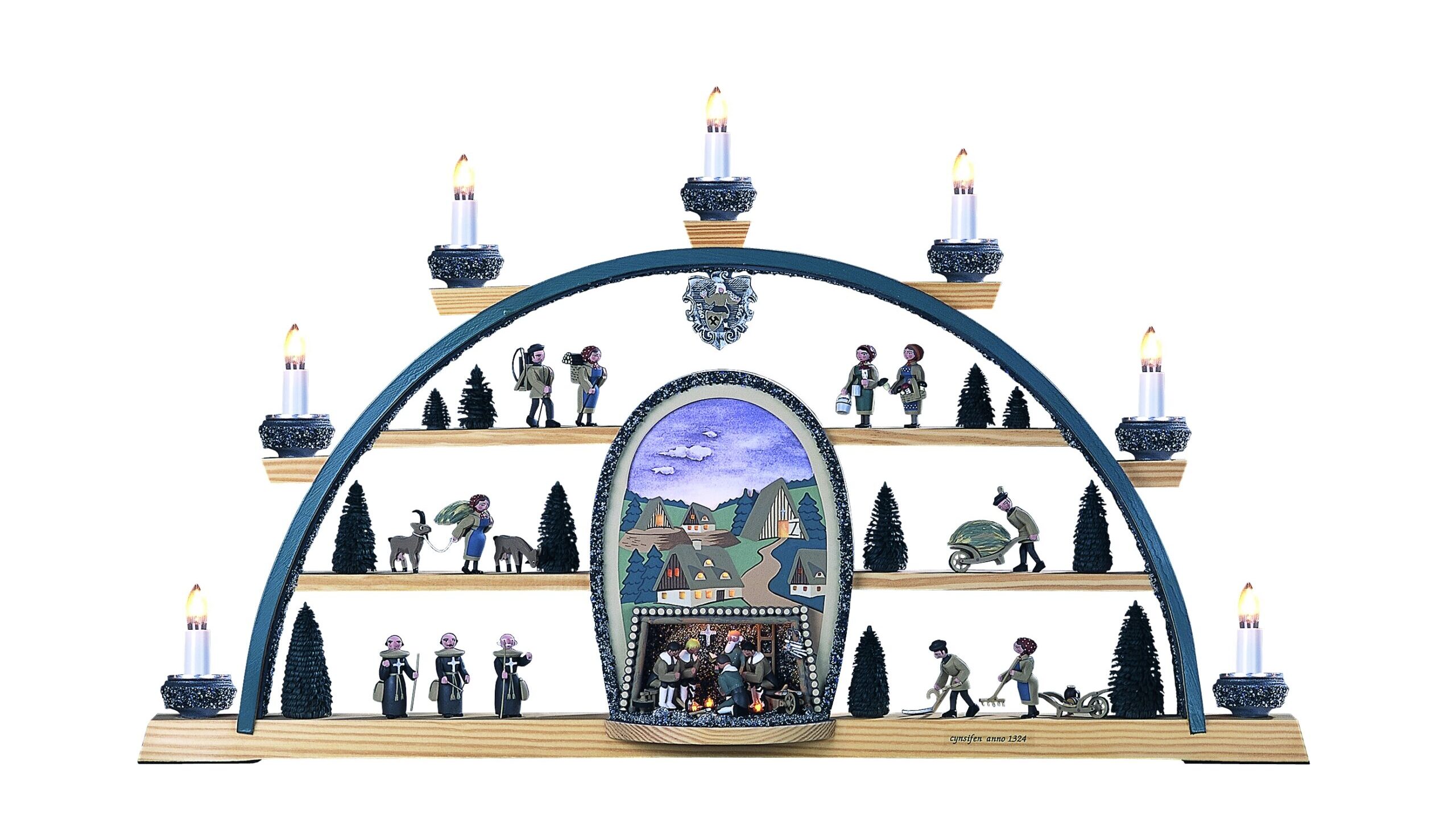
"Cynsifen 1324"
with mountain chapel and Cistercian monks,
Back of Seiffen church
(size 70cm x 40 cm)
with 8 electric candles including interior lighting
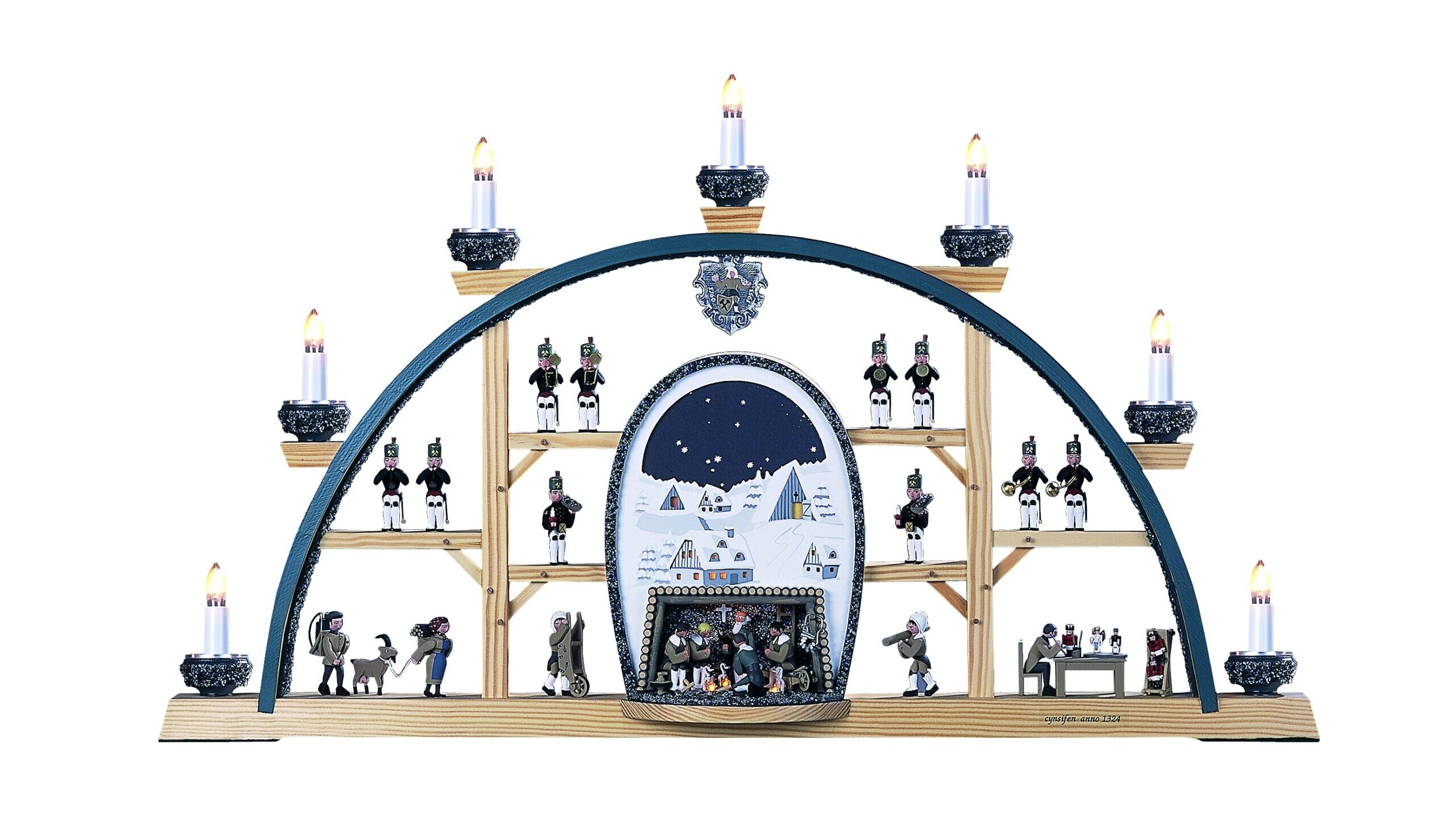
"Cynsifen 1324"
with mountain chapel and winter landscape,
back of Seiffen church,
(size 70cm x 40 cm)
with 8 electric candles including interior lighting
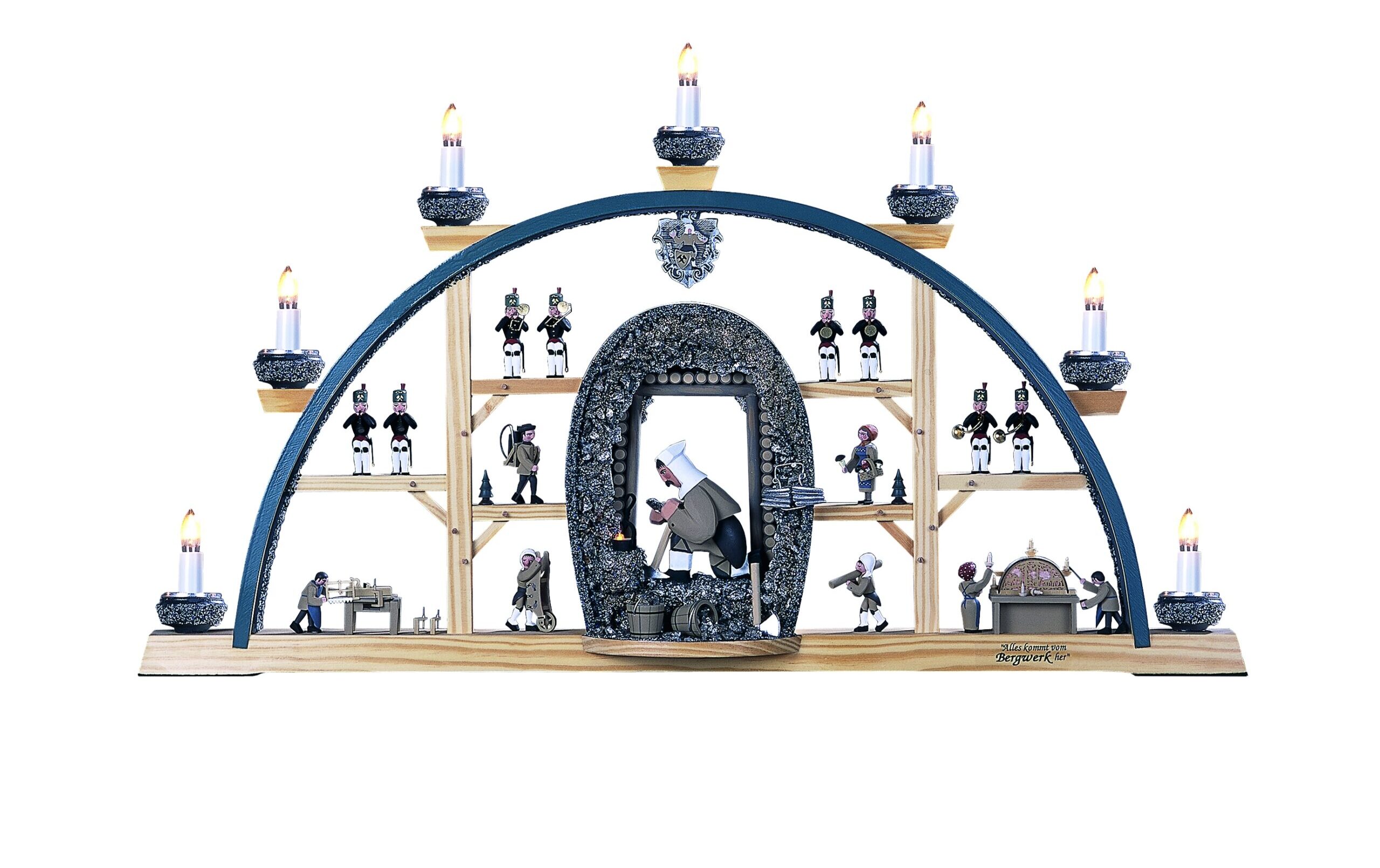
"Miner with find"
(size 70cm x 40cm)
with 8 electric candles including interior lighting
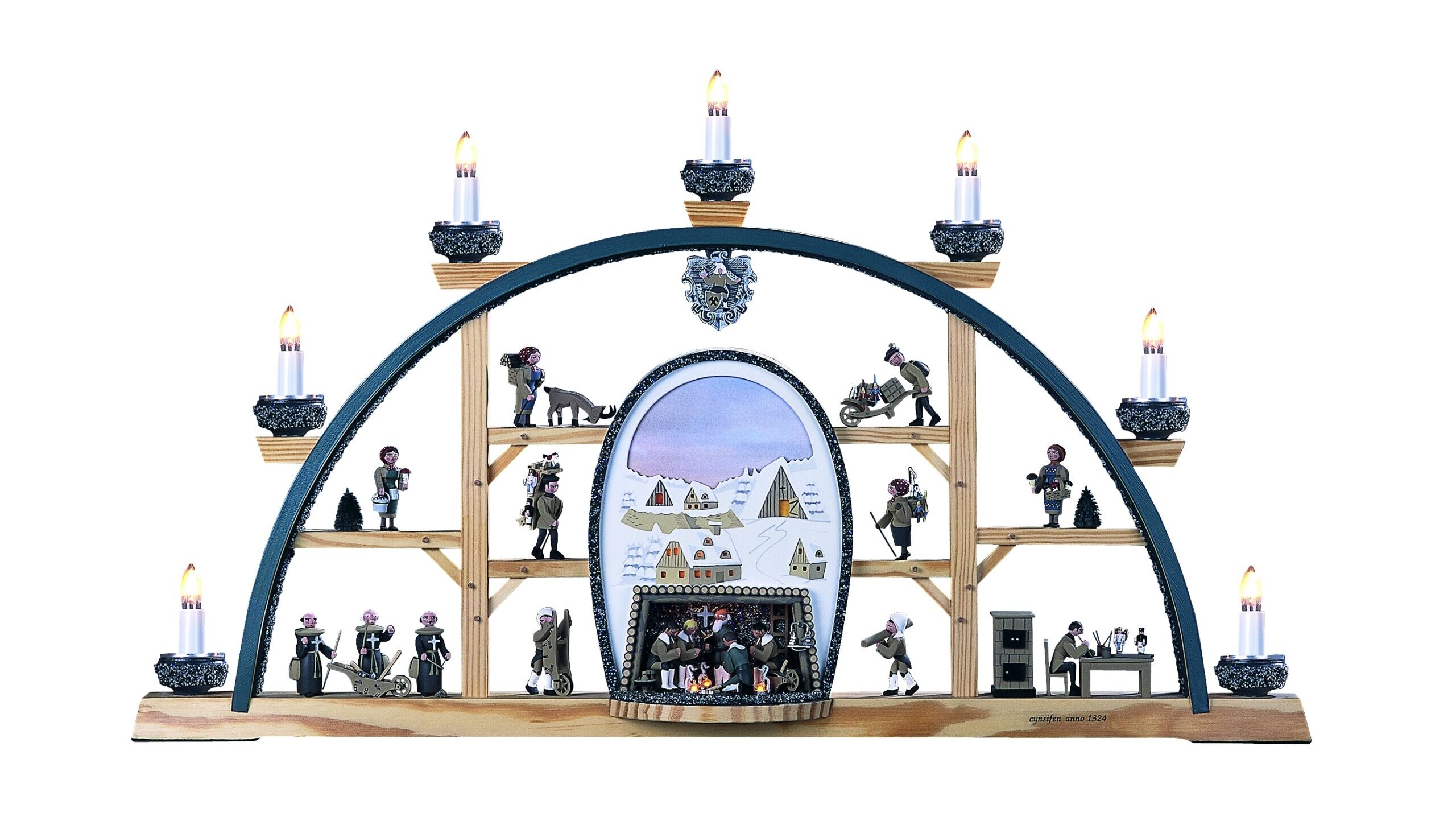
"Cynsifen 1324"
mit Bergkapelle und Winterlandschaft,
Rückseite Seiffener Kirche
(Größe 70cm x 40 cm)
mit 8 elektrischen Kerzen einschließlich Innenbeleuchtung
During the heyday of mining in the Ore Mountains in the 15th and 16th centuries, which was also linked to an economic boom in Saxony, important towns were founded in the Ore Mountains by the Saxon dukes. Within a few years, these towns in the centres of silver mining developed into the important mining towns of Schneeberg (1471), Annaberg (1496) and Marienberg (1521).
As an expression of their wealth, monumental buildings were built there that still characterise the townscape of these once rich silver towns today. The town of Schneeberg was founded in 1471 by Duke Albrecht of Saxony. As early as 1474, 1200 miners were working in 232 mines in and around Schneeberg. The St. Wolfgang Church, which characterises the townscape, was built between 1516 and 1540.
This landmark of Schneeberg is also at the centre of the arch. Below, an episode from the history of Schneeberg is depicted in a tunnel entrance. In 1477, miners from the St. George’s mine came across a huge silver specimen measuring 2 x 2 x 1 m and weighing 400 hundredweight. The find was so sensational that even Duke Albrecht rushed to Schneeberg to see this miracle. He was served food and drink at this “silver table” and is said to have exclaimed: “Our Emperor Frederick may be powerful and rich, but he does not have such a stately table made of pure silver.”
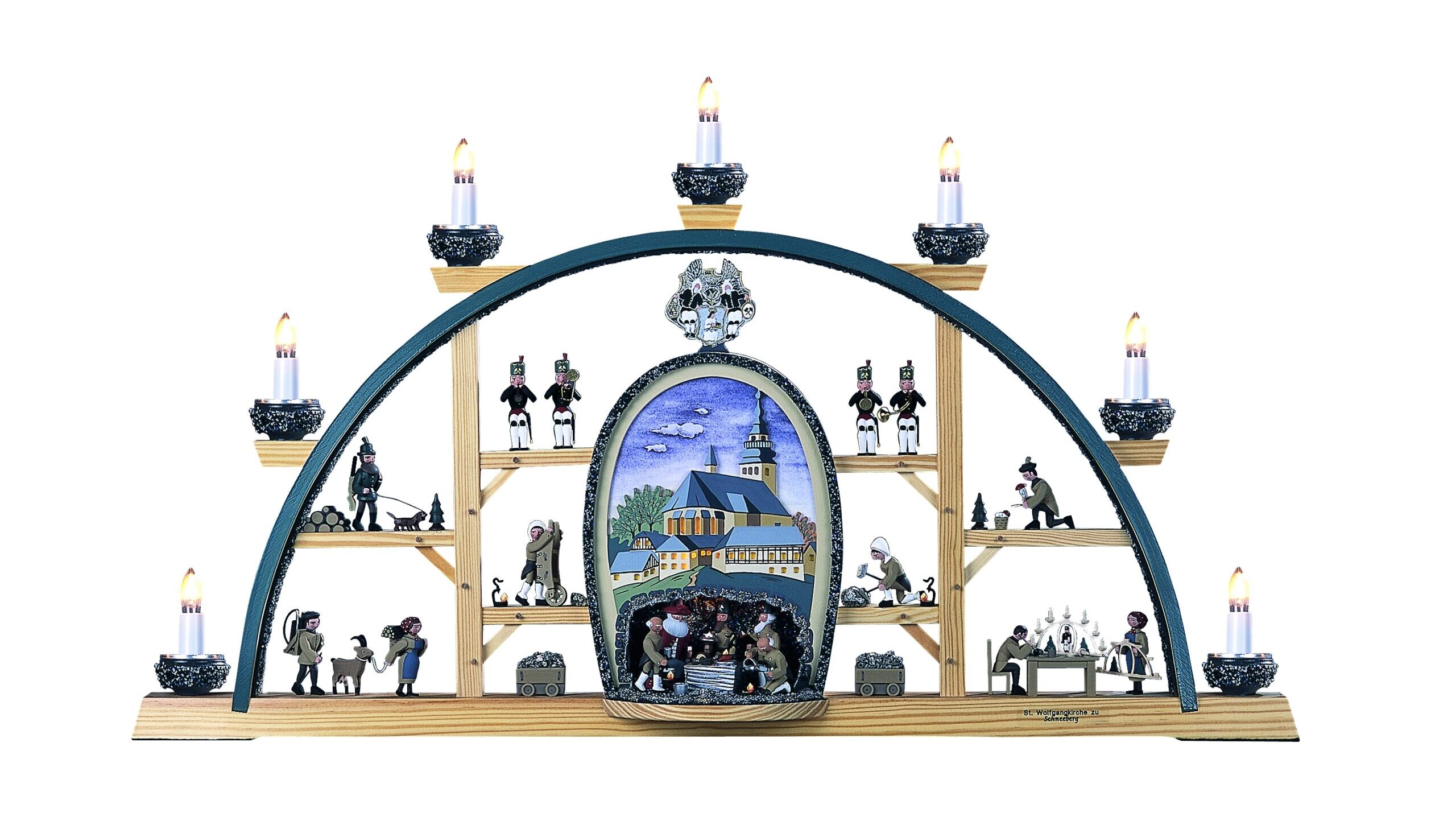
Schneeberger Summer
(Size 70cm x 40 cm) with 8 electric candles including interior lighting
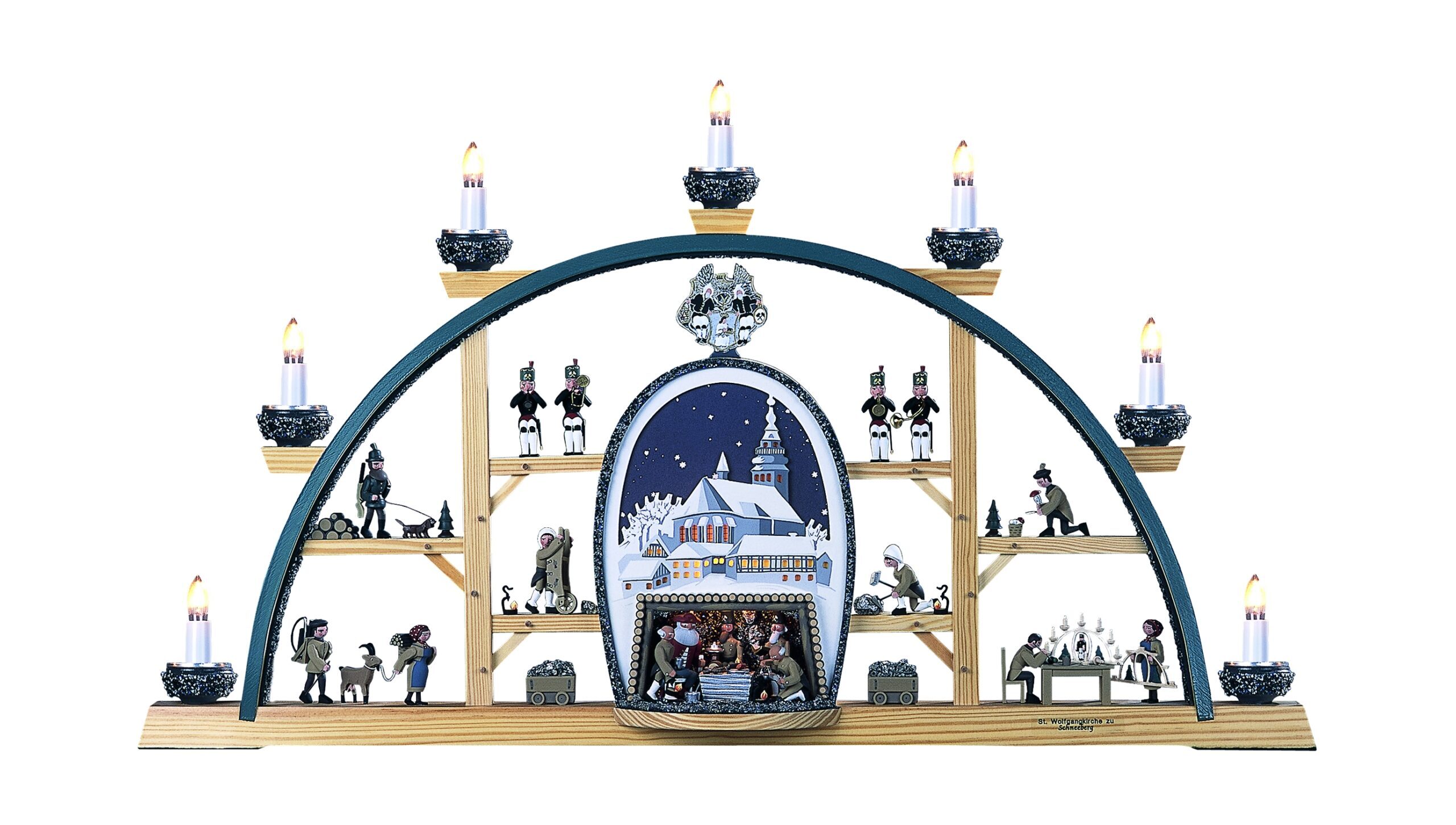
Schneeberger Winter
(Size 70cm x 40 cm) with 8 electric candles including interior lighting
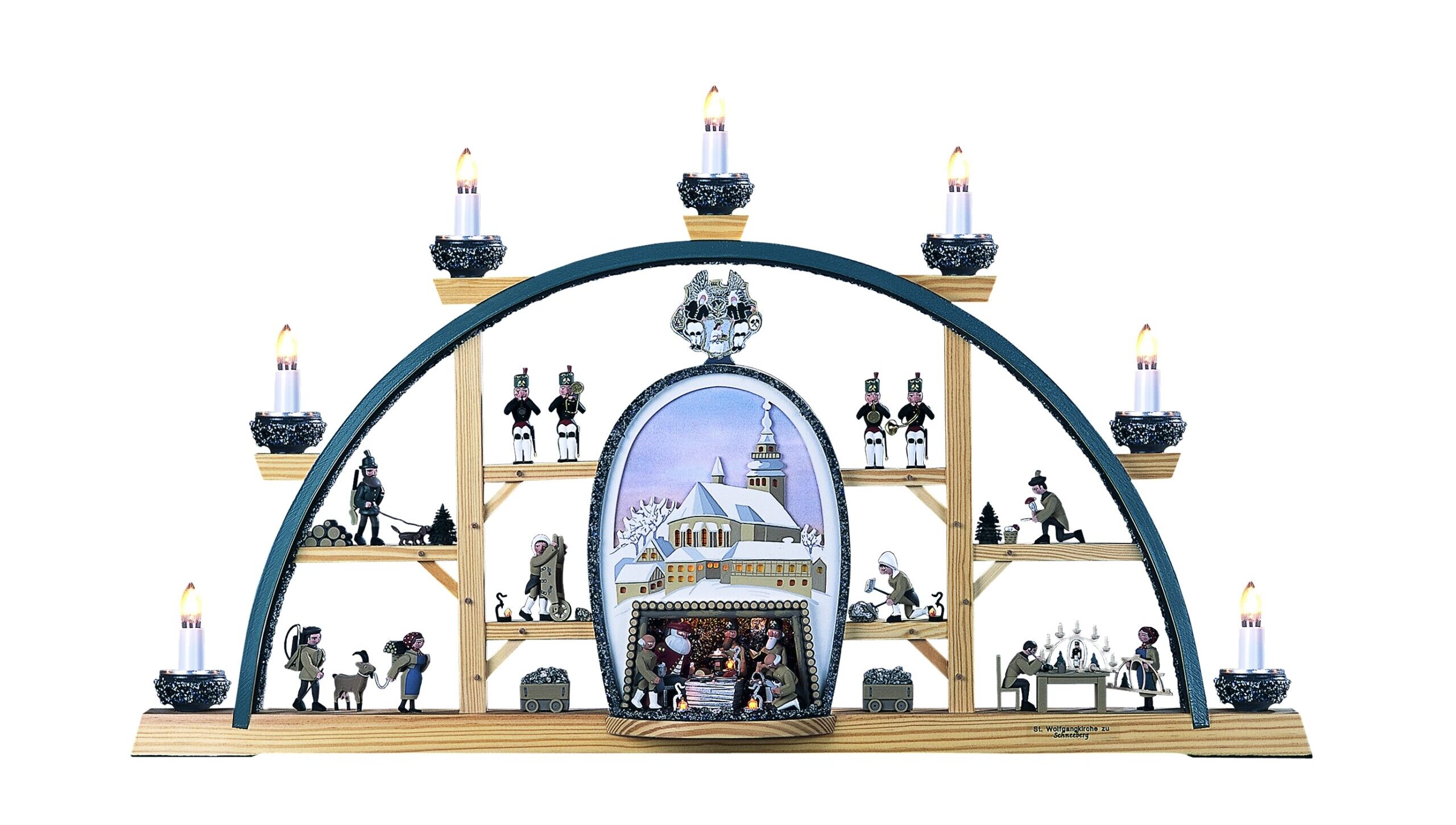
Schneeberger Winter
(Size 70cm x 40 cm) with 8 electric candles including interior lighting

(Size 70cm x 40cm)
with 8 electric candles including interior lighting, mouth hole painted on both sides
The first silver discoveries around 1492 on the Schreckenberg prompted the Saxon Duke George the Bearded to found the “Neustadt am Schreckenberg” in 1496, which was then given the name “St. Annaberg” in 1501 by an imperial coat of arms.
By 1500, Annaberg was already the most important mining town in the Ore Mountains, alongside Freiberg and Schneeberg.
Annaberg’s most outstanding architectural monument is the St. Anne’s Church, built from quarry stone between 1499 and 1525. It is the largest late Gothic hall church in Saxony, which is also the centerpiece of our candle arch.
The work of the German arithmetic master Adam Ries (1492-1559), who worked as a clerk in the Annaberg mining industry and also ran his own arithmetic school, was also closely linked to mining. He also taught Barbara Uthmann (1514–1575) arithmetic and mining science, who also became an important figure in Annaberg. As a publisher, she contributed significantly to the spread of Erzgebirge bobbin lace and thus created a new livelihood for many mining families when mining dried up. These two historical figures are also depicted next to St. Anne’s Church in our arch.
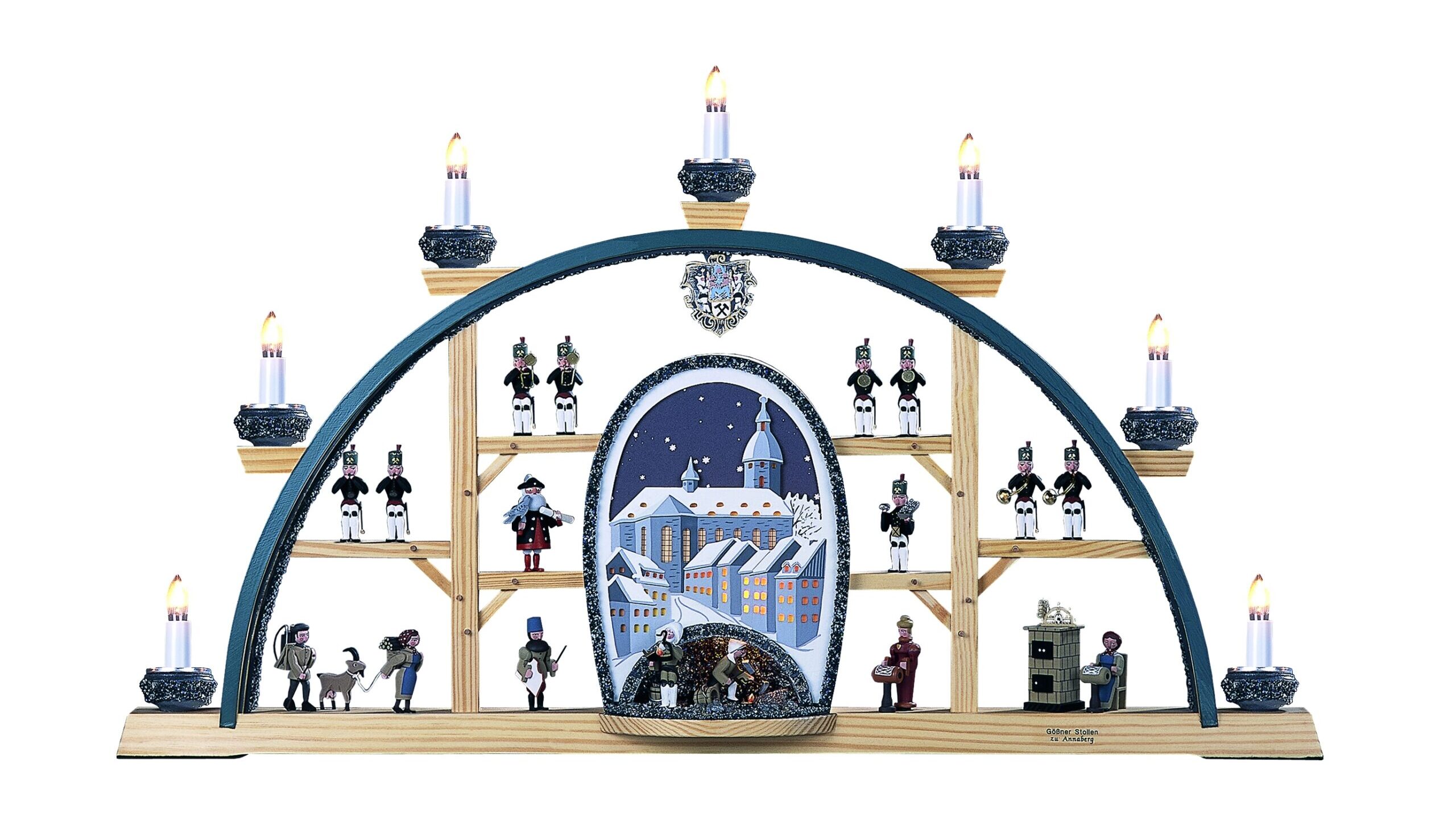
Annaberg
(Size 70cm x 40 cm) with 8 electric candles including interior lighting
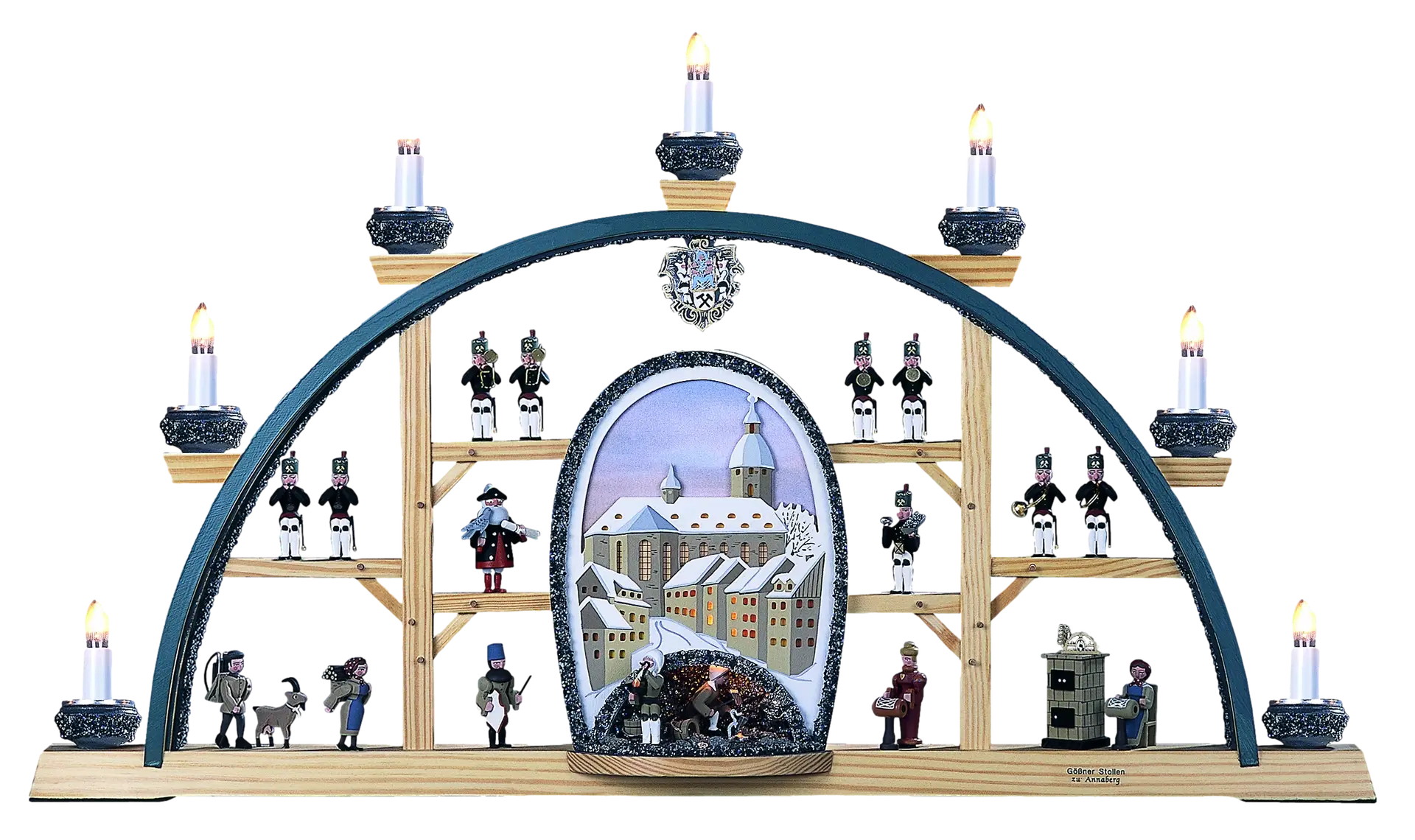
Schneeberger Winter
(Size 70cm x 40 cm) with 8 electric candles including interior lighting
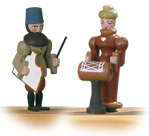
Marienberg is the youngest of the once important mining towns in the Ore Mountains. The first silver discoveries in 1519 in the area of the forest-strip village of Niederschletta attracted numerous miners here too.
This prompted Duke Henry the Pious of Saxony to found a new mining town in 1521. It was built on the land of Wüstenschletta and called Marienberg.
The town was granted full town and mining rights as early as 1523. As a planned town complex, it has a 1.77 hectare square market square. On it, on a base made of Swedish granite, is a larger-than-life bronze monument of the town’s founder, Duke Henry the Pious (1473-1541). In addition to representative secular buildings such as the town hall, the prince’s house as the duke’s former hunting lodge and the mining office, the town church of St. Mary was also built between 1558 and 1564. It is the youngest of the large, late Gothic hall churches in the Ore Mountains.
The monument of the city’s founder, Henry the Pious, and the St. Mary’s Church, which dominates the cityscape, therefore also occupy a central place in this candle arch, surrounded by other mining and folklore depictions.
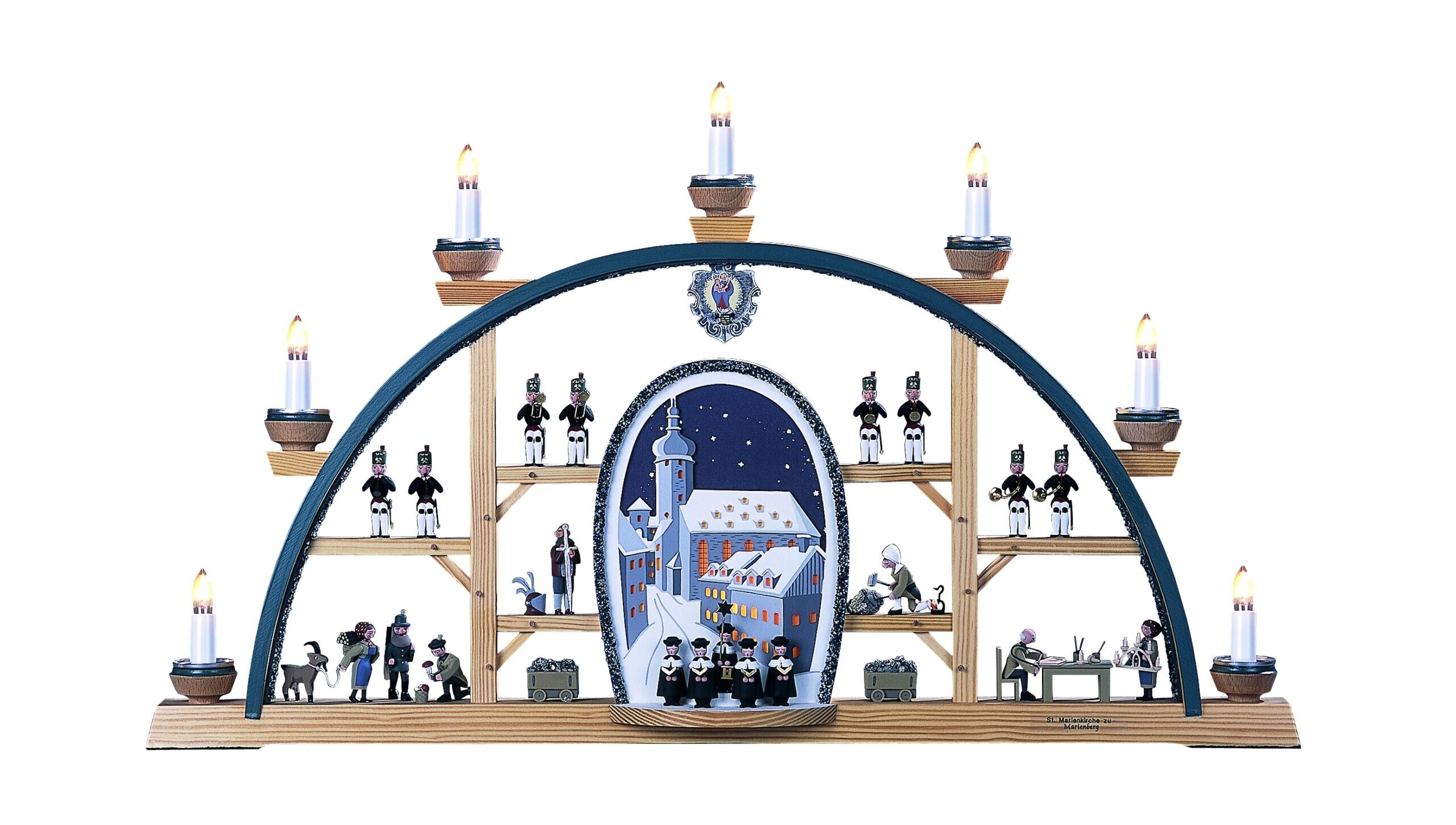
Marienberg
(Size 70cm x 40 cm) with 8 electric candles including interior lighting

Marienberg
(Size 70cm x 40 cm) with 8 electric candles including interior lighting
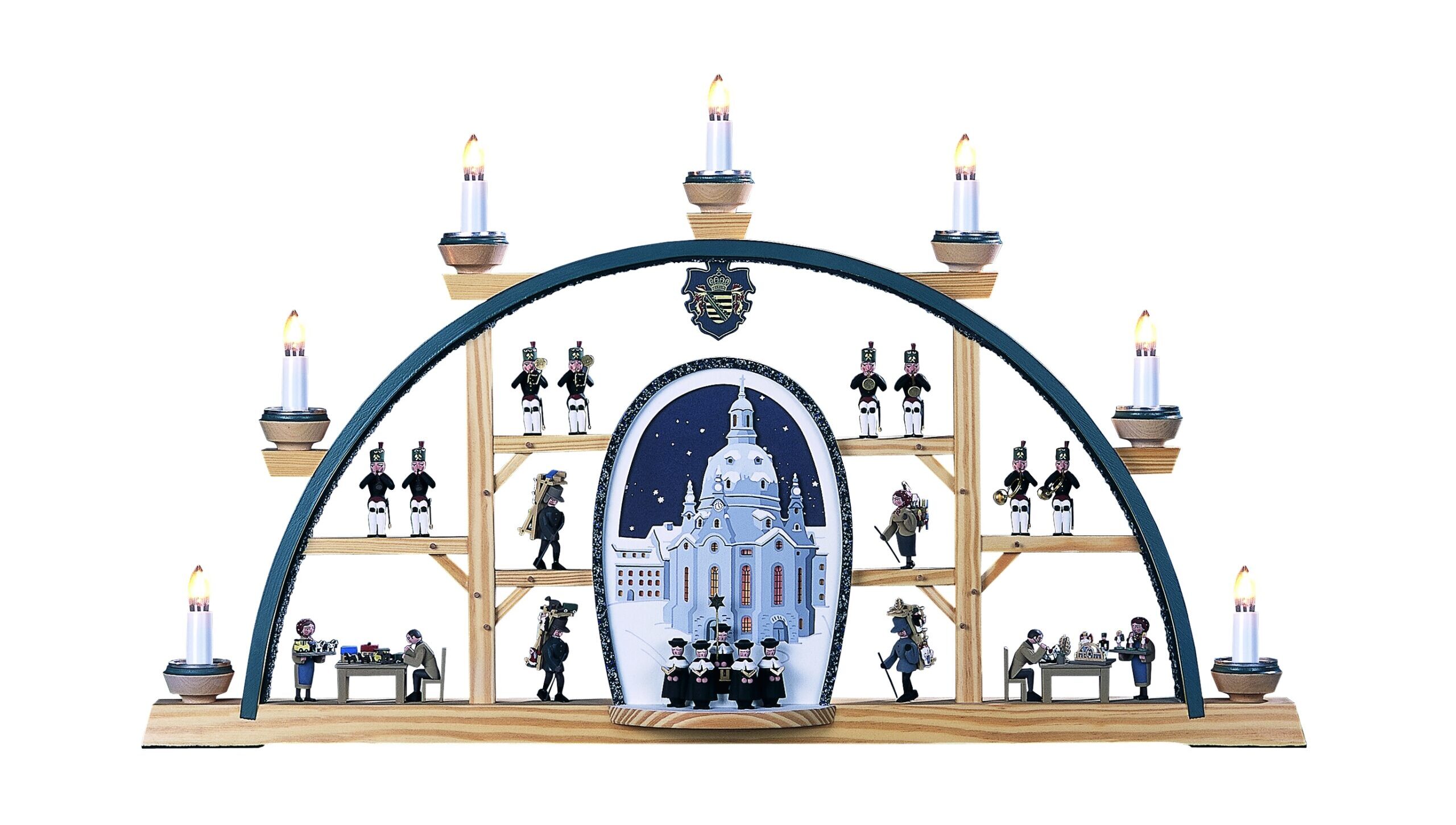
Frauenkirche with four Seiffen toy makers around 1809
(size 70cm x 40 cm) with 8 electric candles including interior lighting, mouth hole painted on both sides
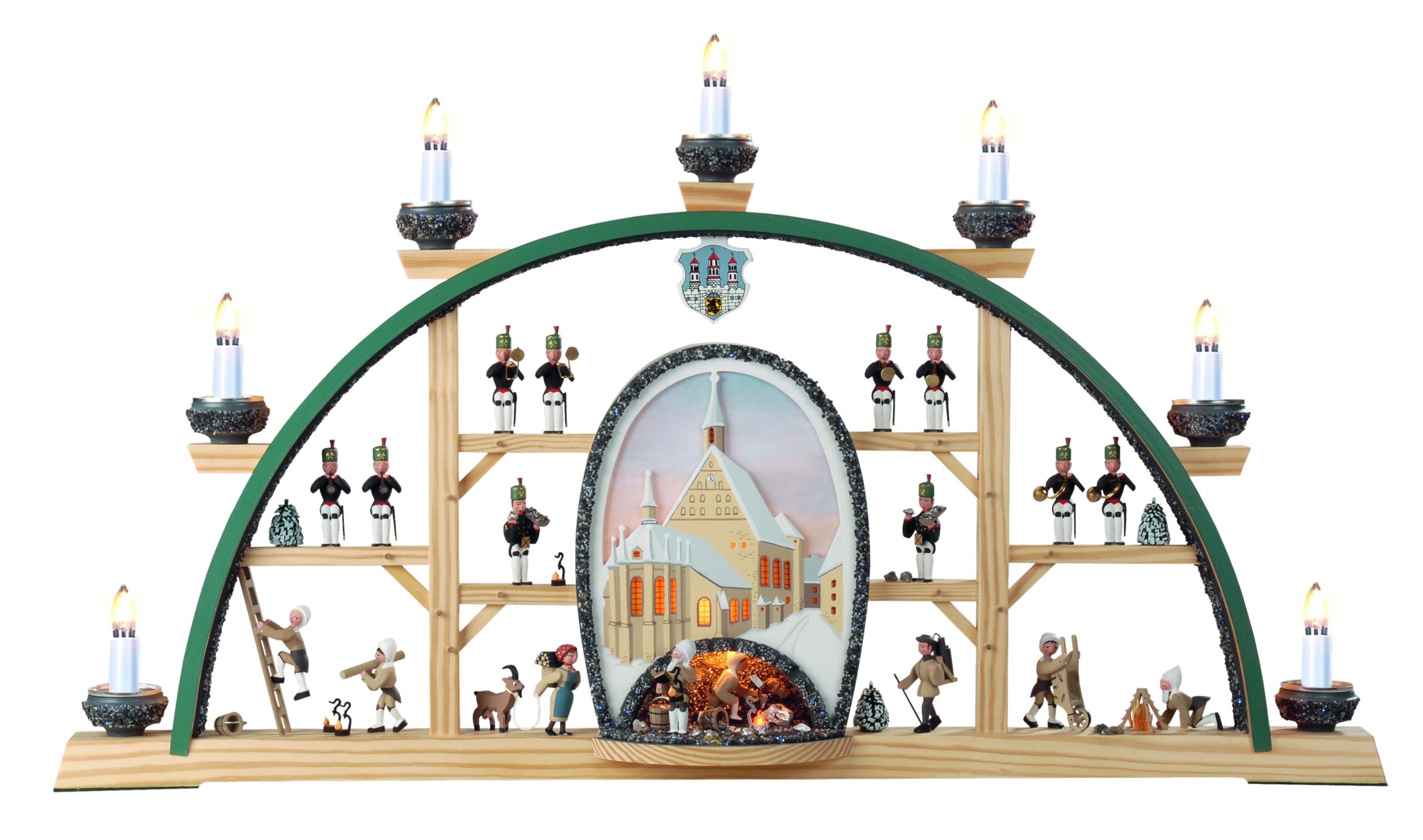
"Freiberg Cathedral"
(Size 70cm x 40 cm) with 8 electric candles including interior lighting, mouth hole painted on both sides

Manufaktur Klaus Kolbe GmbH
Steinhübel 31
09548 Kurort Seiffen
© Copyright 2025 Manufaktur Klaus Kolbe | All Rights Reserved. | realisiert mit d3sign.me
To provide you with the best possible experience, we use technologies such as cookies to store and/or access device information. If you consent to these technologies, we may process data such as browsing behavior or unique IDs on this website. If you do not give or withdraw your consent, certain features and functionality may be affected.